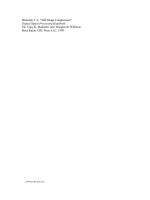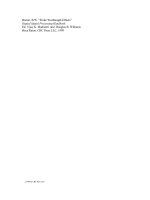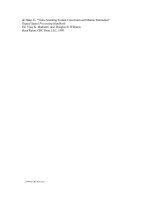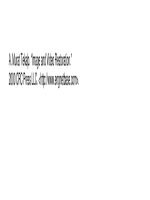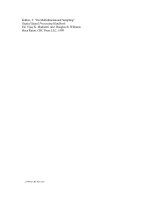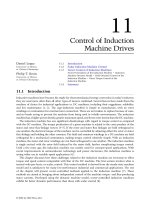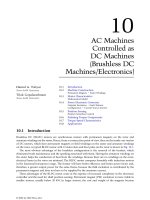Drilling Fluids Processing Handbook P1
Bạn đang xem bản rút gọn của tài liệu. Xem và tải ngay bản đầy đủ của tài liệu tại đây (1.81 MB, 40 trang )
TeAM
YYePG
Digitally signed by TeAM YYePG
DN: cn=TeAM YYePG, c=US,
o=TeAM YYePG, ou=TeAM
YYePG, email=
Reason: I attest to the accuracy
and integrity of this document
Date: 2005.02.22 05:32:12
+08'00'
DRILLING FLUIDS PROCESSING
HANDBOOK
This page intentionally left blank
DRILLING FLUIDS
PROCESSING
HANDBOOK
Asme
AMSTERDAM BOSTON HEIDELBERG LONDON NEW YORK OXFORD
PARIS SAN DIEGO SAN FRANCISCO SINGAPORE SYDNEY TOKYO
Gulf Professional Publishing is an imprint of Elsevier
Gulf Professional Publishing is an imprint of Elsevier
30 Corporate Drive, Suite 400, Burlington, MA 01803, USA
Linacre House, Jordan Hill, Oxford OX2 8DP, UK
Copyright ß 2005, Elsevier Inc. All rights reserved.
No part of this publication may be reproduced, stored in a retrieval system, or
transmitted in any form or by any means, electronic, mechanical, photocopying,
recording, or otherwise, without the prior written permission of the publisher.
Permissions may be sought directly from Elsevier’s Science & Technology Rights
Department in Oxford, UK: phone: (þ44) 1865 843830, fax: (þ44) 1865 853333,
e-mail: You may also complete your request on-line
via the Elsevier homepage (), by selecting ‘‘Customer Support’’
and then ‘‘Obtaining Permissions.’’
Recognizing the importance of preserving what has been wirtten, Elsevier prints
its books on acid-free paper whenever possible.
Library of Congress Cataloging-in-Publication Data
Application submitted.
British Library Cataloguing-in-Publication Data
A catalogue record for this book is available from the British Library.
ISBN 0-7506-7775-9
For information on all Gulf Professional Publishing publications visit our Web site
at www.books.elsevier.com
040506070809 10987654321
Printed in the United States of America
CONTENTS
Biographies xvii
Preface xxiii
1 Historical Perspective and Introduction 1
1.1 Scope 1
1.2 Purpose 1
1.3 Introduction 2
1.4 Historical Perspective 4
1.5 Comments 11
1.6 Waste Management 13
2 Drilling Fluids 15
2.1 Drilling Fluid Systems 15
2.1.1 Functions of Drilling Fluids 15
2.1.2 Types of Drilling Fluids 16
2.1.3 Drilling Fluid Selection 17
2.1.4 Separation of Drilled Solids from Drilling Fluids 20
2.2 Characterization of Solids in Drilling Fluids 25
2.2.1 Nature of Drilled Solids and Solid Additives 25
2.2.2 Physical Properties of Solids in Drilling Fluids 26
2.3 Properties of Drilling Fluids 31
2.3.1 Rheology 32
2.4 Hole Cleaning 38
2.4.1 Detection of Hole-Cleaning Problems 38
2.4.2 Drilling Elements That Affect Hole Cleaning 40
2.4.3 Filtration 45
2.4.4 Rate of Penetration 47
2.4.5 Shale Inhibition Potential/Wetting Characteristics 51
2.4.6 Lubricity 52
2.4.7 Corrosivity 53
2.4.8 Drilling-Fluid Stability and Maintenance 54
v
2.5 Drilling Fluid Products 54
2.5.1 Colloidal and Fine Solids 54
2.5.2 Macropolymers 55
2.5.3 Conventional Polymers 56
2.5.4 Surface-Active Materials 57
2.6 Health, Safety, and Environment and Waste Management 58
2.6.1 Handling Drilling Fluid Products and Cuttings 58
2.6.2 Drilling Fluid Product Compatibility and Storage
Guidelines 58
2.6.3 Waste Management and Disposal 62
References 66
3 Solids Calculation 69
3.1 Procedure for a More Accurate Low-Gravity Solids
Determination 70
3.1.1 Sample Calculation 73
3.2 Determination of Volume Percentage of Low-Gravity Solids
in Water-Based Drilling Fluid 77
3.3 Rig-Site Determination of Specific Gravity of Drilled
Solids 78
4 Cut Points 81
4.1 How to Determine Cut Point Curves 85
4.2 Cut Point Data: Shale Shaker Example 90
5 Tank Arrangement 93
5.1 Active System 94
5.1.1 Suction and Testing Section 94
5.1.2 Additions Section 95
5.1.3 Removal Section 95
5.1.4 Piping and Equipment Arrangement 96
5.1.5 Equalization 98
5.1.6 Surface Tanks 99
5.1.7 Sand Traps 100
5.1.8 Degasser Suction and Discharge Pit 102
5.1.9 Desander Suction and Discharge Pits 102
5.1.10 Desilter Suction and Discharge Pits (Mud Cleaner/
Conditioner) 103
5.1.11 Centrifuge Suction and Discharge Pits 103
5.2 Auxiliary Tank System 104
5.2.1 Trip Tank 104
5.3 Slug Tank 105
5.4 Reserve Tank(s) 105
vi Contents
6 Scalping Shakers and Gumbo Removal 107
7 Shale Shakers 111
7.1 How a Shale Shaker Screens Fluid 113
7.2 Shaker Description 116
7.3 Shale Shaker Limits 118
7.3.1 Fluid Rheological Properties 119
7.3.2 Fluid Surface Tension 120
7.3.3 Wire Wettability 120
7.3.4 Fluid Density 120
7.3.5 Solids: Type, Size, and Shape 120
7.3.6 Quantity of Solids 121
7.3.7 Hole Cleaning 121
7.4 Shaker Development Summary 121
7.5 Shale Shaker Design 122
7.5.1 Shape of Motion 123
7.5.2 Vibrating Systems 133
7.5.3 Screen Deck Design 134
7.5.4 g Factor 136
7.5.5 Power Systems 140
7.6 Selection of Shale Shakers 143
7.6.1 Selection of Shaker Screens 145
7.6.2 Cost of Removing Drilled Solids 145
7.6.3 Specific Factors 146
7.7 Cascade Systems 148
7.7.1 Separate Unit 150
7.7.2 Integral Unit with Multiple Vibratory Motions 150
7.7.3 Integral Unit with a Single Vibratory Motion 152
7.7.4 Cascade Systems Summary 152
7.8 Dryer Shakers 153
7.9 Shaker User’s Guide 154
7.9.1 Installation 155
7.9.2 Operation 156
7.9.3 Maintenance 157
7.9.4 Operating Guidelines 158
7.10 Screen Cloths 159
7.10.1 Common Screen Cloth Weaves 160
7.10.2 Revised API Designation System 167
7.10.3 Screen Identification 174
7.11 Factors Affecting Percentage-Separated Curves 174
7.11.1 Screen Blinding 176
7.11.2 Materials of Construction 177
7.11.3 Screen Panels 178
Contents vii
7.11.4 Hook-Strip Screens 180
7.11.5 Bonded Screens 180
7.11.6 Three-Dimensional Screening Surfaces 180
7.12 Non-Oilfield Drilling Uses of Shale Shakers 181
7.12.1 Microtunneling 181
7.12.2 River Crossing 182
7.12.3 Road Crossing 182
7.12.4 Fiber-Optic Cables 182
8 Settling Pits 183
8.1 Settling Rates 183
8.2 Comparison of Settling Rates of Barite and Low-Gravity Drilled
Solids 186
8.3 Comments 187
8.4 Bypassing the Shale Shaker 188
9 Gas Busters, Separators, and Degassers 189
9.1 Introduction: General Comments on Gas Cutting 189
9.2 Shale Shakers and Gas Cutting 192
9.3 Desanders, Desilters, and Gas Cutting 192
9.4 Centrifuges and Gas Cutting 193
9.5 Basic Equipment for Handling Gas-Cut Mud 193
9.5.1 Gravity Separation 195
9.5.2 Centrifugal Separation 195
9.5.3 Impact, Baffle, or Spray Separation 195
9.5.4 Parallel-Plate and Thin-Film Separation 196
9.5.5 Vacuum Separation 196
9.6 Gas Busters 196
9.7 Separators 197
9.7.1 Atmospheric Separators 197
9.7.2 West Texas Separator 198
9.8 Pressurized Separators 199
9.8.1 Commercial Separator/Flare Systems 199
9.8.2 Pressurized, or Closed, Separators: Modified
Production Separators 200
9.8.3 Combination System: Separator and Degasser 202
9.9 Degassers 202
9.9.1 Degasser Operations 203
9.9.2 Degasser Types 205
9.9.3 Pump Degassers or Atmospheric Degassers 207
9.9.4 Magna-Vac
TM
Degasser 207
9.10 Points About Separators and Separation 209
References 210
viii Contents
10 Suspension, Agitation, and Mixing of Drilling Fluids 213
10.1 Basic Principles of Agitation Equipment 213
10.2 Mechanical Agitators 214
10.2.1 Impellers 215
10.2.2 Gearbox 222
10.2.3 Shafts 222
10.3 Equipment Sizing and Installation 223
10.3.1 Design Parameters 223
10.3.2 Compartment Shape 226
10.3.3 Tank and Compartment Dimensions 226
10.3.4 Tank Internals 226
10.3.5 Baffles 227
10.3.6 Sizing Agitators 227
10.3.7 Turnover Rate (TOR) 228
10.4 Mud Guns 232
10.4.1 High-Pressure Mud Guns 233
10.4.2 Low-Pressure Mud Guns 233
10.4.3 Mud Gun Placement 234
10.4.4 Sizing Mud Gun Systems 235
10.5 Pros and Cons of Agitation Equipment 237
10.5.1 Pros of Mechanical Agitators 238
10.5.2 Cons of Mechanical Agitators 238
10.5.3 Pros of Mud Guns 238
10.5.4 Cons of Mud Guns 238
10.6 Bernoulli’s Principle 239
10.6.1 Relationship of Pressure, Velocity, and Head 240
10.7 Mud Hoppers 244
10.7.1 Mud Hopper Installation and Operation 246
10.7.2 Mud Hopper Recommendations 248
10.7.3 Other Shearing Devices 250
10.8 Bulk Addition Systems 250
10.9 Tank/Pit Use 253
10.9.1 Removal 253
10.9.2 Addition 254
10.9.3 Suction 254
10.9.4 Reserve 255
10.9.5 Discharge 255
10.9.6 Trip Tank 255
References 255
11 Hydrocyclones 257
11.1 Discharge 261
11.2 Hydrocyclone Capacity 265
Contents ix
11.3 Hydrocyclone Tanks and Arrangements 266
11.3.1 Desanders 267
11.3.2 Desilters 268
11.3.3 Comparative Operation of Desanders and
Desilters 269
11.3.4 Hydrocyclone Feed Header Problems 269
11.4 Median (D
50
) Cut Points 270
11.4.1 Stokes’ Law 271
11.5 Hydrocyclone Operating Tips 276
11.6 Installation 278
11.7 Conclusions 279
11.7.1 Errata 281
12 Mud Cleaners 283
12.1 History 286
12.2 Uses of Mud Cleaners 288
12.3 Non-Oilfield Use of Mud Cleaners 291
12.4 Location of Mud Cleaners in a Drilling-Fluid System 291
12.5 Operating Mud Cleaners 292
12.6 Estimating the Ratio of Low-Gravity Solids Volume and Barite
Volume in Mud Cleaner Screen Discard 293
12.7 Performance 295
12.8 Mud Cleaner Economics 297
12.9 Accuracy Required for Specific Gravity of Solids 300
12.10 Accurate Solids Determination Needed to Properly Identify
Mud Cleaner Performance 300
12.11 Heavy Drilling Fluids 301
13 Centrifuges 303
13.1 Decanting Centrifuges 303
13.1.1 Stokes’ Law and Drilling Fluids 308
13.1.2 Separation Curves and Cut Points 308
13.1.3 Drilling-Fluids Solids 310
13.2 The Effects of Drilled Solids and Colloidal Barite on
Drilling Fluids 311
13.3 Centrifugal Solids Separation 313
13.3.1 Centrifuge Installation 316
13.3.2 Centrifuge Applications 316
13.3.3 The Use of Centrifuges with Unweighted Drilling
Fluids 317
13.3.4 The Use of Centrifuges with Weighted Drilling
Fluids 317
x Contents
13.3.5 Running Centrifuges in Series 318
13.3.6 Centrifuging Drilling Fluids with Costly Liquid
Phases 320
13.3.7 Flocculation Units 320
13.3.8 Centrifuging Hydrocyclone Underflows 321
13.3.9 Operating Reminders 321
13.3.10 Miscellaneous 321
13.4 Rotary Mud Separator 321
13.4.1 Problem 1 322
13.5 Solutions to the Questions in Problem 1 324
13.5.1 Question 1 324
13.5.2 Question 2 324
13.5.3 Question 3 324
13.5.4 Question 4 325
13.5.5 Question 5 325
13.5.6 Question 6 325
13.5.7 Question 7 325
13.5.8 Question 8 325
13.5.9 Question 9 326
13.5.10 Question 10 326
14 Use of the Capture Equation to Evaluate the Performance
of Mechanical Separation Equipment Used to Process
Drilling Fluids 327
14.1 Procedure 330
14.1.1 Collecting Data for the Capture Analysis 330
14.1.2 Laboratory Analysis 330
14.2 Applying the Capture Calculation 331
14.2.1 Case 1: Discarded Solids Report to Underflow 331
14.2.2 Case 2: Discarded Solids Report to Overflow 331
14.2.3 Characterizing Removed Solids 331
14.3 Use of Test Results 332
14.3.1 Specific Gravity 332
14.3.2 Particle Size 332
14.3.3 Economics 333
14.4 Collection and Use of Supplementary Information 334
15 Dilution 335
15.1 Effect of Porosity 337
15.2 Removal Efficiency 338
15.3 Reasons for Drilled-Solids Removal 339
15.4 Diluting as a Means for Controlling Drilled Solids 340
15.5 Effect of Solids Removal System Performance 341
Contents xi
15.6 Four Examples of the Effect of Solids Removal Equipment
Efficiency 342
15.6.1 Example 1 343
15.6.2 Example 2 344
15.6.3 Example 3 346
15.6.4 Example 4 347
15.6.5 Clean Fluid Required to Maintain 4%vol Drilled
Solids 347
15.7 Solids Removal Equipment Efficiency for Minimum Volume of
Drilling Fluid to Dilute Drilled Solids 348
15.7.1 Equation Derivation 349
15.7.2 Discarded Solids 350
15.8 Optimum Solids Removal Equipment Efficiency (SREE) 351
15.9 Solids Removal Equipment Efficiency in an
Unweighted Drilling Fluid from Field Data 354
15.9.1 Excess Drilling Fluid Built 356
15.10 Estimating Solids Removal Equipment Efficiency for a
Weighted Drilling Fluid 357
15.10.1 Solution 358
15.10.2 Inaccuracy in Calculating Discard Volumes 360
15.11 Another Method of Calculating the Dilution Quantity 361
15.12 Appendix: American Petroleum Institute Method 361
15.12.1 Drilled Solids Removal Factor 361
15.12.2 Questions 362
15.13 A Real-Life Example 362
15.13.1 Exercise 1 362
15.13.2 Exercise 2 364
15.13.3 Exercise 3 365
15.13.4 Exercise 4 365
15.13.5 General Comments 366
16 Waste Management 367
16.1 Quantifying Drilling Waste 367
16.1.1 Example 1 368
16.1.2 Example 2 368
16.1.3 Example 3 369
16.1.4 Example 4 370
16.1.5 Example 5 371
16.1.6 Example 6 372
16.2 Nature of Drilling Waste 372
16.3 Minimizing Drilling Waste 374
16.3.1 Total Fluid Management 375
16.3.2 Environmental Impact Reduction 377
xii Contents
16.4 Offshore Disposal Options 377
16.4.1 Direct Discharge 378
16.4.2 Injection 378
16.4.3 Collection and Transport to Shore 380
16.4.4 Commercial Disposal 380
16.5 Onshore Disposal Options 382
16.5.1 Land Application 382
16.5.2 Burial 386
16.6 Treatment Techniques 391
16.6.1 Dewatering 391
16.6.2 Thermal Desorption 395
16.6.3 Solidification/Stabilization 397
16.7 Equipment Issues 399
16.7.1 Augers 400
16.7.2 Vacuums 402
16.7.3 Cuttings Boxes 403
16.7.4 Cuttings Dryers 406
References 412
17 The AC Induction Motor 413
17.1 Introduction to Electrical Theory 413
17.2 Introduction to Electromagnetic Theory 421
17.3 Electric Motors 423
17.3.1 Rotor Circuits 424
17.3.2 Stator Circuits 425
17.4 Transformers 427
17.5 Adjustable Speed Drives 429
17.6 Electric Motor Applications on Oil Rigs 432
17.6.1 Ratings 432
17.6.2 Energy Losses 433
17.6.3 Temperature Rise 434
17.6.4 Voltage 435
17.7 Ambient Temperature 435
17.8 Motor Installation and Troubleshooting 438
17.9 Electric Motor Standards 439
17.10 Enclosure and Frame Designations 441
17.10.1 Protection Classes Relating to
Enclosures 443
17.11 Hazardous Locations 444
17.12 Motors for Hazardous Duty 449
17.13 European Community Directive 94/9/EC 451
17.14 Electric Motors for Shale Shakers 454
17.15 Electric Motors for Centrifuges 459
Contents xiii
17.16 Electric Motors for Centrifugal Pumps 459
17.17 Study Questions 460
18 Centrifugal Pumps 465
18.1 Impeller 465
18.2 Casing 467
18.3 Sizing Centrifugal Pumps 470
18.3.1 Standard Definitions 471
18.3.2 Head Produces Flow 479
18.4 Reading Pump Curves 480
18.5 Centrifugal Pumps Accelerate Fluid 484
18.5.1 Cavitation 485
18.5.2 Entrained Air 486
18.6 Concentric vs Volute Casings 488
18.6.1 Friction Loss Tables 490
18.7 Centrifugal Pumps and Standard Drilling Equipment 491
18.7.1 Friction Loss and Elevation Considerations 491
18.8 Net Positive Suction Head 503
18.8.1 System Head Requirement (SHR) Worksheet 506
18.8.2 Affinity Laws 506
18.8.3 Friction Loss Formulas 507
18.9 Recommended Suction Pipe Configurations 508
18.9.1 Supercharging Mud Pumps 510
18.9.2 Series Operation 512
18.9.3 Parallel Operation 513
18.9.4 Duplicity 513
18.10 Standard Rules for Centrifugal Pumps 513
18.11 Exercises 514
18.11.1 Exercise 1 514
18.11.2 Exercise 2: System Head Requirement
Worksheet 515
18.11.3 Exercise 3 517
18.11.4 Exercise 4 517
18.12 Appendix 518
18.12.1 Answers to Exercise 1 518
18.12.2 Answers to Exercise 2: System Head Requirement
Worksheet 518
18.12.3 Answers to Exercise 3 520
18.12.4 Answers to Exercise 4 520
19 Solids Control in Underbalanced Drilling 521
19.1 Underbalanced Drilling Fundamentals 521
19.1.1 Underbalanced Drilling Methods 523
xiv Contents
19.2 Air/Gas Drilling 523
19.2.1 Environmental Contamination 524
19.2.2 Drilling with Natural Gas 525
19.2.3 Sample Collection While Drilling with Air or
Gas 526
19.2.4 Air or Gas Mist Drilling 527
19.3 Foam Drilling 529
19.3.1 Disposable Foam Systems 529
19.3.2 Recyclable Foam Systems 530
19.3.3 Sample Collection While Drilling with Foam 532
19.4 Liquid/Gas (Gaseated) Systems 532
19.5 Oil Systems, Nitrogen/Diesel Oil, Natural Gas/Oil 535
19.5.1 Sample Collection with Aerated Systems 535
19.6 Underbalanced Drilling with Conventional Drilling Fluids or
Weighted Drilling Fluids 536
19.7 General Comments 537
19.7.1 Pressurized Closed Separator System 538
19.8 Possible Underbalanced Drilling Solids-Control Problems 539
19.8.1 Shale 539
19.8.2 Hydrogen Sulfide Gas 540
19.8.3 Excess Formation Water 540
19.8.4 Downhole Fires and Explosions 540
19.8.5 Very Small Air- or Gas-Drilled Cuttings 541
19.8.6 Gaseated or Aerated Fluid Surges 541
19.8.7 Foam Control 542
19.8.8 Corrosion Control 542
Suggested Reading 542
20 Smooth Operations 547
20.1 Derrickman’s Guidelines 548
20.1.1 Benefits of Good Drilled-Solids Separations 549
20.1.2 Tank and Equipment Arrangements 549
20.1.3 Shale Shakers 550
20.1.4 Things to Check When Going on Tour 552
20.1.5 Sand Trap 552
20.1.6 Degasser 553
20.1.7 Hydrocyclones 554
20.1.8 Hydrocyclone Troubleshooting 557
20.1.9 Mud Cleaners 558
20.1.10 Centrifuges 560
20.1.11 Piping to Materials Additions (Mixing) Section 561
20.2 Equipment Guidelines 562
20.2.1 Surface Systems 562
Contents xv
